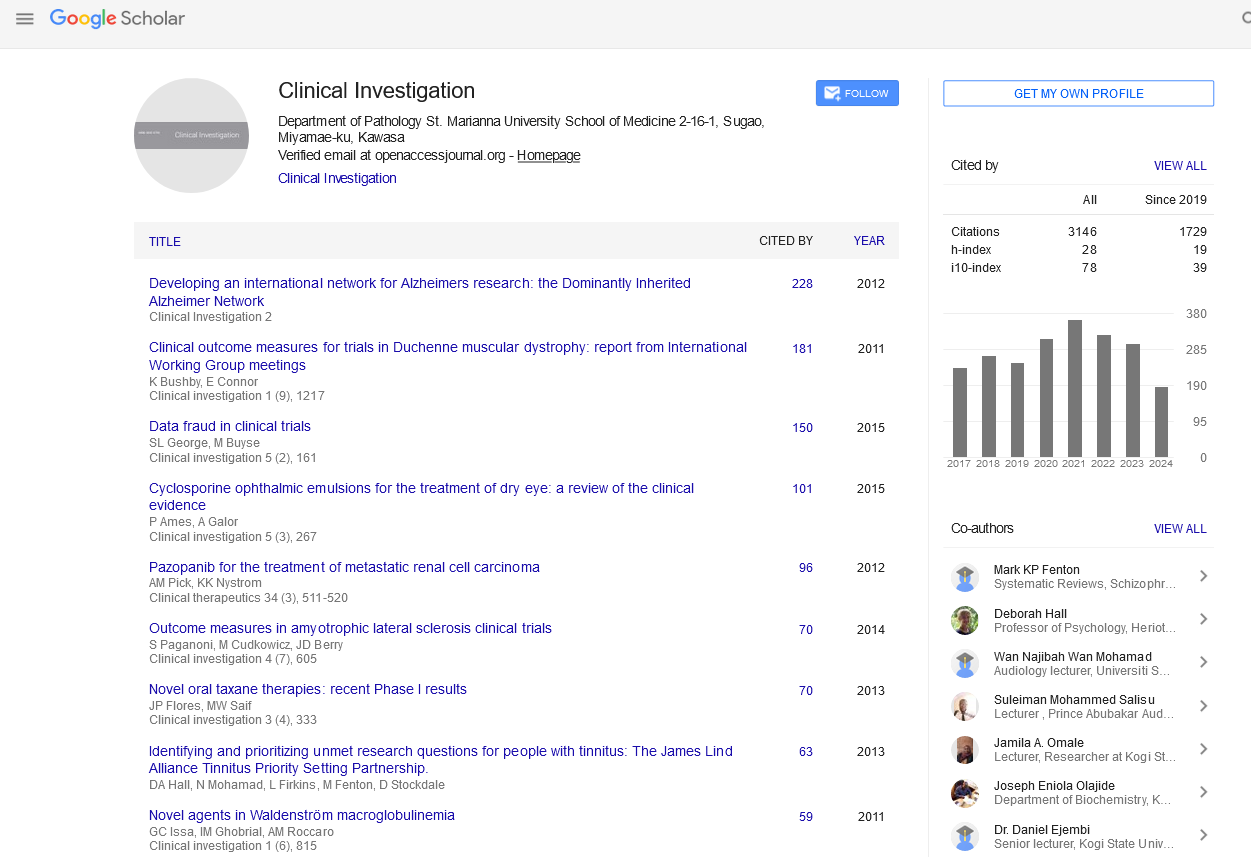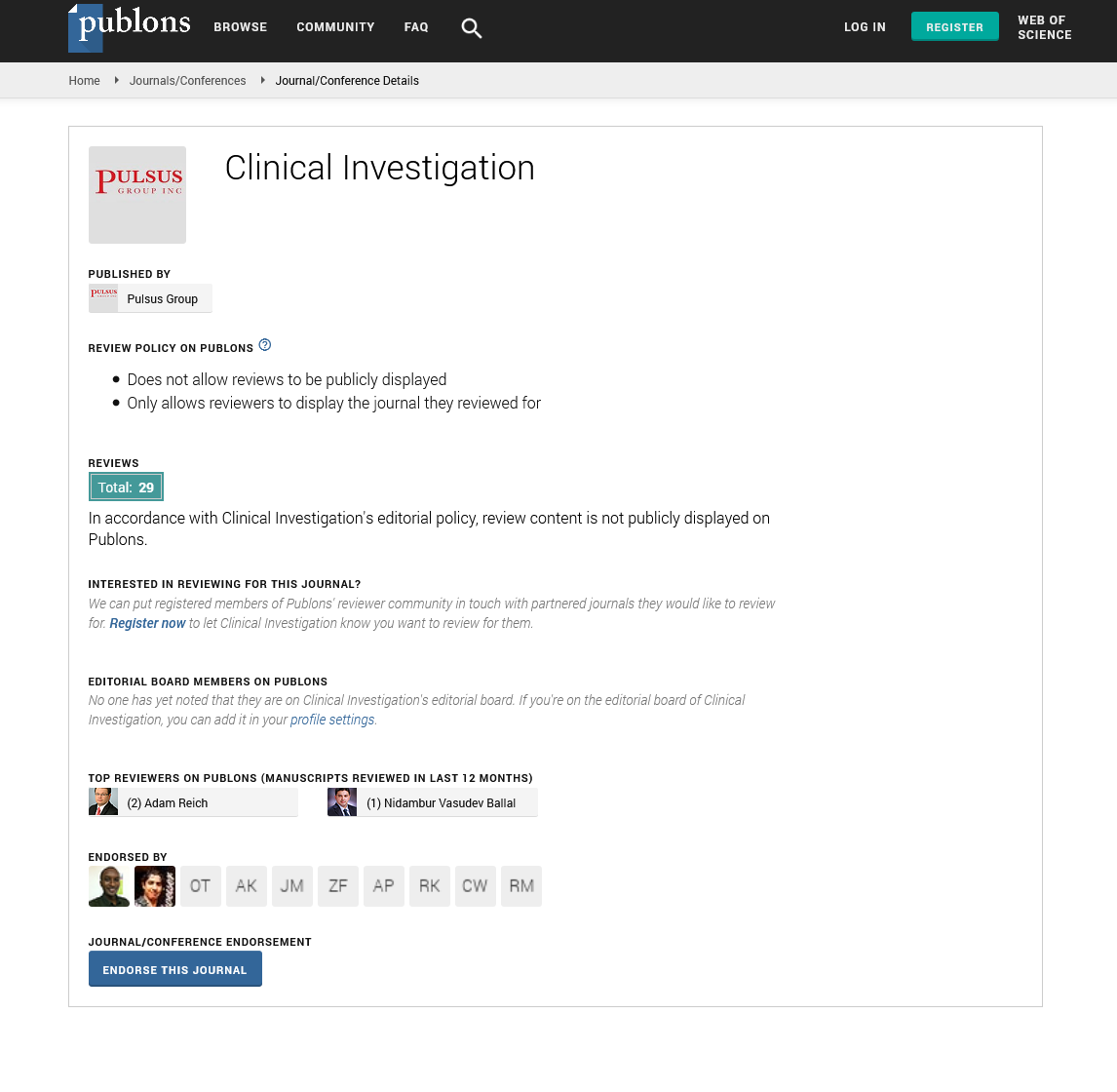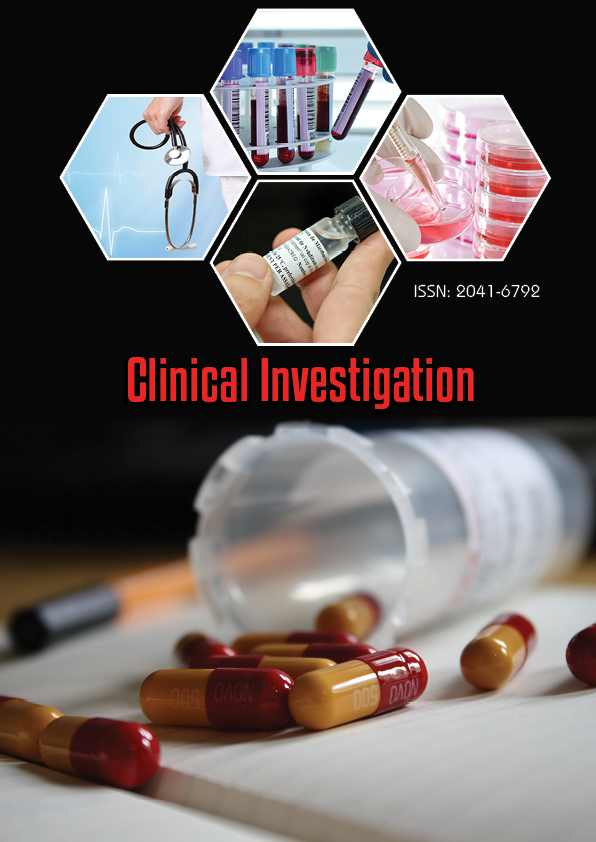Opinion Article - Clinical Investigation (2024) Volume 14, Issue 4
Angiogenesis: Mechanisms, Roles, and Implications in Health and Disease
- Corresponding Author:
- Radhika Sharma
Faculty of Biology, Delhi University, India
E-mail: Radhikasharma@ gmail.com
Received: 3-April-2024, Manuscript No. fmci-25-160353; Editor assigned: 5-April-2024, PreQC No fmci-25-160353(PQ); Reviewed: 13-April-2024, QC No. fmci-25-160353(Q); Revised: 22-April-2024, Manuscript No. fmci-25-160353(R); Published: 29-April-2024
Abstract
Angiogenesis, the process by which new blood vessels form from pre-existing vessels, is a critical biological event that supports tissue growth, wound healing, and the response to hypoxia. This complex process involves a variety of cellular and molecular mechanisms, including endothelial cell proliferation, migration, and vessel maturation. Angiogenesis is tightly regulated, and its dysregulation can lead to pathological conditions, such as cancer, cardiovascular diseases, and diabetic retinopathy. This article explores the mechanisms of angiogenesis, its role in normal physiology, and the implications of abnormal angiogenesis in various diseases. Additionally, it discusses potential therapeutic strategies targeting angiogenesis for both disease treatment and tissue regeneration. Understanding angiogenesis offers critical insights into disease pathology and provides opportunities for the development of novel therapeutic approaches.
Keywords
Angiogenesis • Blood vessels • Endothelial cells • Hypoxia • Vascular Endothelial Growth Factor (VEGF) • Cancer • Cardiovascular diseases • Tissue regeneration
Introduction
Angiogenesis, the formation of new blood vessels from pre-existing ones, is a fundamental process in physiology and disease. It plays a crucial role in the development of tissues during embryogenesis, in wound healing, and in the adaptation of tissues to changes in oxygen demand (hypoxia). The process is regulated by a balance of pro-angiogenic and antiangiogenic signals, where endothelial cells—the primary cells lining the blood vessels proliferate, migrate, and organize to form new vascular structures.
Angiogenesis is essential for many biological processes, including tissue repair after injury, the growth of tumors, and the development of the placenta during pregnancy. However, when this process is dysregulated, it can contribute to several diseases, such as cancer, cardiovascular diseases, and retinal disorders. The ability to control angiogenesis has become a key target in therapeutic strategies aimed at both promoting and inhibiting vascular growth.
This article delves into the mechanisms and regulation of angiogenesis, its role in various physiological and pathological conditions, and the therapeutic implications of modulating this process.
Mechanisms of angiogenesis
The process of angiogenesis is regulated by a series of molecular and cellular events, which are activated by both intrinsic signals (such as genetic factors) and extrinsic stimuli (such as hypoxia and growth factors). The key stages of angiogenesis include endothelial cell activation, migration, proliferation, and the formation of new vascular structures.
• Hypoxia and Vascular Endothelial Growth Factor (VEGF): One of the most critical stimuli for angiogenesis is hypoxia, or low oxygen levels in tissues. When tissues experience oxygen deprivation, cells release signaling molecules that promote angiogenesis. One of the most important proangiogenic factors induced by hypoxia is Vascular Endothelial Growth Factor (VEGF). VEGF binds to receptors on endothelial cells, initiating signaling pathways that promote endothelial cell proliferation, migration, and the formation of new blood vessels.
• Endothelial cell activation and migration: Following the activation by VEGF and other growth factors, endothelial cells become "activated" and undergo morphological changes that allow them to migrate toward the site of hypoxia or injury. These cells then proliferate, forming tubular structures that eventually mature into functional blood vessels. The migration of endothelial cells is guided by a combination of growth factors, extracellular matrix components, and integrins.
• Formation of lumen and vessel maturation: As endothelial cells continue to proliferate and migrate, they organize into tubular structures, forming the basic framework for new blood vessels. The formation of a lumen the hollow central space within blood vessels is a critical step in angiogenesis, allowing for the circulation of blood. The new vessels also undergo maturation through the recruitment of supporting cells such as pericytes and smooth muscle cells, which stabilize and strengthen the vessels.
• Role of notch signaling: In addition to VEGF, Notch signaling plays a pivotal role in the regulation of angiogenesis. Notch signaling helps regulate endothelial cell differentiation and the formation of functional blood vessels. It also plays a crucial role in determining the branching pattern of the vasculature and ensuring the appropriate coordination between endothelial cells and surrounding support cells.
Angiogenesis in health and disease
• Normal physiological angiogenesis: In healthy tissues, angiogenesis occurs primarily during developmental stages, wound healing, and during the menstrual cycle. For instance, during embryogenesis, angiogenesis forms the initial vascular network that supports organ development. In adult tissues, angiogenesis is critical for wound healing after injury, as new blood vessels are formed to supply oxygen and nutrients to the healing tissue. Similarly, angiogenesis is essential during the menstrual cycle, where it is involved in the formation of the blood vessels in the endometrium, preparing the uterus for possible implantation of a fertilized egg. In the case of pregnancy, angiogenesis ensures adequate blood flow to the placenta and supports fetal development.
• Angiogenesis in cancer: In cancer, angiogenesis plays a critical role in tumor growth and metastasis. Tumors require an adequate blood supply to provide oxygen and nutrients for their rapid growth. As tumors grow, they often outstrip their existing blood supply and create a hypoxic microenvironment. This leads to the release of pro-angiogenic signals, primarily VEGF, which stimulates the growth of new blood vessels into the tumor. Tumor vasculature is typically disorganized and dysfunctional, which can contribute to the characteristic irregular blood flow in tumors. However, the formation of new blood vessels is essential for the survival and progression of the tumor. Antiangiogenic therapies, such as bevacizumab, aim to block the VEGF pathway to prevent tumor angiogenesis and starve the tumor of its blood supply.
• Cardiovascular diseases: In cardiovascular diseases, impaired angiogenesis can contribute to the progression of ischemic conditions, such as coronary artery disease. When blood vessels become narrowed or blocked due to atherosclerosis, tissues in the heart or other organs may become deprived of oxygen. The ability of the body to generate new blood vessels to bypass blockages known as collateral circulation can significantly improve outcomes for patients with ischemic heart disease. However, in certain cardiovascular conditions, excessive or abnormal angiogenesis may also contribute to pathological remodeling, such as in the formation of blood vessels during atherosclerotic plaque development, leading to plaque rupture and subsequent heart attacks or strokes.
• Diabetic retinopathy: Diabetic retinopathy is a complication of diabetes where abnormal angiogenesis in the retina leads to the formation of fragile and leaky blood vessels. These abnormal vessels can lead to hemorrhages, retinal detachment, and even blindness. In this case, the goal is often to inhibit angiogenesis and stabilize the blood vessels to prevent further vision loss.
• Wound healing and tissue regeneration: In normal wound healing, angiogenesis plays a crucial role in repairing damaged tissues. The formation of new blood vessels helps to restore blood supply to the wound site, providing oxygen and nutrients necessary for tissue repair. Additionally, in regenerative medicine, promoting angiogenesis is a key strategy for improving the healing of chronic wounds, burns, and tissue defects.
Therapeutic implications and strategies
Given the crucial role of angiogenesis in health and disease, manipulating this process has significant therapeutic potential.
• Anti-Angiogenic therapy: In diseases where excessive angiogenesis contributes to pathological conditions, such as cancer and diabetic retinopathy, therapies aimed at inhibiting angiogenesis have been developed. These therapies often target molecules like VEGF or its receptors, preventing the formation of new blood vessels. Anti-angiogenic drugs, such as bevacizumab and aflibercept, are used in treating certain cancers and eye conditions.
• Pro-Angiogenic therapy: In conditions where insufficient angiogenesis is a problem such as in ischemic heart disease, stroke, or chronic wounds pro-angiogenic therapies are being explored. These therapies seek to stimulate the formation of new blood vessels to improve blood supply to the affected tissues. Growth factors like VEGF and Fibroblast Growth Factors (FGFs) are being investigated for their potential to promote vascular growth and tissue regeneration.
• Gene therapy and nanomedicine: Advances in gene therapy and nanomedicine are providing new strategies to control angiogenesis. Gene therapy can be used to deliver pro-angiogenic factors directly to tissues that need new blood vessels, while nanomedicine may offer targeted delivery of angiogenesis-related drugs to specific sites, enhancing the efficacy and minimizing side effects.
Conclusion
Angiogenesis is a vital process in both normal physiological functions and in the pathogenesis of various diseases. Its regulation is crucial for maintaining healthy tissue function, and its dysregulation can lead to conditions ranging from cancer to cardiovascular disease and diabetic retinopathy. Understanding the mechanisms that control angiogenesis has opened new doors for therapeutic interventions, both in promoting vascular growth for tissue regeneration and inhibiting abnormal angiogenesis in disease. As research continues to explore the complex signaling pathways involved, new therapeutic strategies are likely to emerge, offering hope for the treatment of a wide range of conditions where angiogenesis plays a pivotal role.


